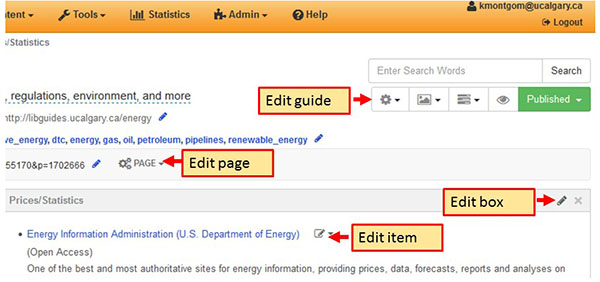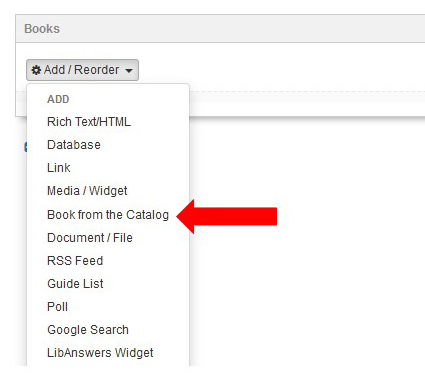Best Practice Guide for LibGuides
Help with LibGuides
Login to LibGuides
Access to LibGuides is through your LibApps login - this is the same login used to access LibAnswers. Alternatively, use your UCalgary login. For either, you will need a LibApps login, which is usually created for you as part of the onboarding process - if you are having problems logging in, contact the Library's IT by creating a Samanage ticket.
Go to: https://ucalgary.libapps.com/libapps/login.php?site_id=546

Overview of guide title and information areas
- Title
- Description
- Type/group and friendly URL
- Subjects and tags
- Ownership and editors
Items 1, 2, and 4 are indexed by Primo.
Item 3: choosing a Type/group is mandatory for the guide to show up on the guide homepage (https://library.ucalgary.ca/guides).

Personal profile and how to create a contact page
Personal profile boxes will not appear on the homepage of each LibGuide. Instead, create a "Contact" page and place it at the bottom of the left-column. This item will direct users to a profile page generated from your personal profile.
Follow the document below to update your personal profile and create a "Contact" page.
Editing at the Guide, Page, Box and Item Levels

Assets
When updating your guides or creating new guides create and “reuse” assets as much as possible. This makes updating guides in the future much easier because an asset only needs to be updated once, even if it is on several guides.
There are 2 types of assets:
- Content assets – includes books from the LMS, links, documents or files, media, widgets, RSS feeds, LibAnswers items, and LibWizard items.
- Database assets – most of the U of C databases are now part of our library of database assets - If you notice a database that is present on the U of C list of subscribed databases, but does not appear in the list of database assets in LibGuides, please notify Doug McDonnell)
When adding an asset, check first to see whether the asset has already been added to the system. Assets are all listed under the “Content” tab. Click “Assets” and you can then search the Content assets or Database assets for the resource you wish to reuse in your guide. Note that several of the fields are searchable – name, description, owner and date created. You may also sort columns to facilitate searching.
Deleting assets
You may delete an asset from a guide but the asset will only be removed from that guide. The asset will remain in the system (where it can be re-used), and may be accessed through the "Content" tab in the toolbar. Only an asset owner may permanently delete an asset from the system.
Add editors or change owners of LibGuides
Add editors
A guide can only have one owner, but many editors. NOTE: the owner of the guide will be the default contact
Guide editors are allowed to create and edit content on the guide and change the guide properties, excluding the Guide Status.
To add other users as editors for your LibGuide, click the "Guide information" icon and select "Guide editors" from the drop-down menu.


NOTE: if you wish to create a new editor-level account for someone who is not in the system, contact Doug McDonnell by placing a Samanage request.
Change Owners
This must be done by owners when there are staffing changes or changes in responsibility. Note that only guide owners and their guides will be listed in the "by owner" area of our list of guides; those with editorial access to the guides will not be listed with the guides that they can edit, nor will those who are listed as "subject experts" be listed with their guides there.
Only guide owners may change ownership of their guides. To change Guide ownership, use the "Content" tab on the toolbar and select "Guides". If the owner has left the institution, and there are guides still assigned to them, contact Doug McDonnell by placing a Samanage request to change ownership.
LibGuide Types, Group, and Subjects
Type
When updating/creating guides be sure to assign a "guide type" so your guides may be more accessible to users. The LibGuides Working Group recommends that the U of C Guide Types are limited to 3 classifications:
- Subject guides
- Course guides
- How do I guides (this is a designation custom to LCR, but is equivalent to LibGuides' "General Purpose" guides)
This decision was based on our review of many academic LibGuides sites where there seems to be great confusion over the classification of guides as "topic guides" or "subject guides".
To assign a guide type to your guides, use the "tool" icon in the upper left corner of your guide. Alternatively the guide type may be assigned when a new guide is created.

Group
In addition to assigning a "type" it is necessary to assign your guide to "Research Guides". This ensures that it will show up on LCR's list of LibGuides by subject and owner.
Friendly URL's
If you create a friendly url you must use: 'guides/friendly-url' for it to show up on the homepage guides list (see image above)
Subjects & Tags

Subjects
In addition to assigning a "type" and "group" it is highly recommended that you affiliate your guides with a "Subject".
- The subjects you choose will affect where your guide is displayed on the Research Guides by Subject page. (They are also the subjects that govern our A-Z database list.)
- Consider these subjects as liaison areas, disciplines, or departments. If your guide does not fall under a subject area, and you would like to associate additional terms with your guide, see "Tags", below
Tags
Tags are uncontrolled words or phrases. Add them if your guide does not fit into any of the subjects above, or if you would like to add additional terms for findability and relevance ranking.
- Limit the number of tags per guide to 3
- When choosing tags, consider how users would search for your guide. For example, students would likely search for “CSE”, and not “Council of Science Editors” when looking for that citation style. So tagging with just CSE would be sufficient.
- Let the auto-complete feature work when adding a tag. It will suggest existing tags already in our system. Select the tag, or hit Enter after typing each tag.
- Separate words in a multi-word tag with a space and then hit the Enter key (or avoid multi-word tags altogether)
- Most of our tags start with a lowercase letter, so please only use uppercase as necessary.
- If your guide is associated with a subject area, there is no need to repeat the subject as a tag
Tabbed boxes
These allow you to include multiple tabs of content in a single box - it's a great way to include a lot of content without taking up a lot of space!
Setting up a Tabbed Box
Select "Tabbed" as the box type you would like to use, and give the box a title.
Click the Cog icon ![]() in the box's header.
in the box's header.
On the Add/Edit Tabs pane, give the first tab a name and click Create New Tab.
Give your next tab a name and click Create New Tab again.

Adding books from the LMS
Use this function to display and link to books and journals in your LibGuide.
Items must be added one at a time.
Always check to make sure the item is not already in the system before adding as a new asset.
After entering the ISBN, if book info is found, the title, author, and publication date fields will be automatically populated.
If a book is not found you can look for alternative ISBN's for that book, or simply add the information manually.


- Last Updated: Nov 24, 2022 10:21 AM
- URL: https://libguides.ucalgary.ca/guides/bestpractice
- Print Page



